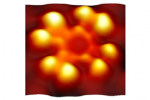
Single-molecule chemistry with a scanning tunneling microscope has preponderantly been performed on metal surfaces. The molecule− metal hybridization, however, is often detrimental to genuine molecular properties and obscures their changes upon chemical reactions. We used graphene on Ir(111) to reduce the coupling between Ir(111) and adsorbed phthalocyanine molecules. By local electron injection from the tip of a scanning tunneling microscope the two pyrrolic H atoms were removed from single phthalocyanines. The detachment of the H atom pair induced a strong modification of the molecular electronic structure, albeit with no change in the adsorption geometry. Spectra and maps of the diff erential conductance combined with density functional calculations unveiled the entire depopulation of the highest occupied molecular orbital upon H abstraction. Occupied π states of intact molecules are proposed to be emptied via intramolecular electron transfer to dangling σ states of H-free N atoms.

N’hésitez pas à consulter le communiqué de presse associé à cet article : De la chimie « mono-moléculaire » sur graphène
References:
Depopulation of Single-Phthalocyanine Molecular Orbitals upon Pyrrolic-Hydrogen Abstraction on Graphene
Nicolas Néel, Marie Lattelais, Marie-Laure Bocquet, and Jörg Kröger
ACS Nano 2016, 10, 2010−2016
doi: 10.1021/acsnano.5b06153
Depopulation of Single-Phthalocyanine Molecular Orbitals upon Pyrrolic-Hydrogen Abstraction on Graphene
